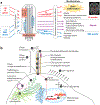The Joubert-Meckel-Nephronophthisis Spectrum of Ciliopathies
- PMID: 35655331
- PMCID: PMC9437135
- DOI: 10.1146/annurev-genom-121321-093528
The Joubert-Meckel-Nephronophthisis Spectrum of Ciliopathies
Abstract
The Joubert syndrome (JS), Meckel syndrome (MKS), and nephronophthisis (NPH) ciliopathy spectrum could be the poster child for advances and challenges in Mendelian human genetics over the past half century. Progress in understanding these conditions illustrates many core concepts of human genetics. The JS phenotype alone is caused by pathogenic variants in more than 40 genes; remarkably, all of the associated proteins function in and around the primary cilium. Primary cilia are near-ubiquitous, microtubule-based organelles that play crucial roles in development and homeostasis. Protruding from the cell, these cellular antennae sense diverse signals and mediate Hedgehog and other critical signaling pathways. Ciliary dysfunction causes many human conditions termed ciliopathies, which range from multiple congenital malformations to adult-onset single-organ failure. Research on the genetics of the JS-MKS-NPH spectrum has spurred extensive functional work exploring the broadly important role of primary cilia in health and disease. This functional work promises to illuminate the mechanisms underlying JS-MKS-NPH in humans, identify therapeutic targets across genetic causes, and generate future precision treatments.
Keywords: Joubert; Meckel; ciliopathies; genetics; nephronophthisis.
Figures






References
-
- Abdelhamed ZA, Wheway G, Szymanska K, Natarajan S, Toomes C, et al. 2013. Variable expressivity of ciliopathy neurological phenotypes that encompass Meckel-Gruber syndrome and Joubert syndrome is caused by complex de-regulated ciliogenesis, Shh and Wnt signalling defects. Hum. Mol. Genet 22:1358–72 - PMC - PubMed
-
- Alazami AM, Alshammari MJ, Baig M, Salih MA, Hassan HH, Alkuraya FS. 2014. NPHP4 mutation is linked to cerebello-oculo-renal syndrome and male infertility. Clin. Genet 85:371–75 - PubMed
Publication types
MeSH terms
Substances
Supplementary concepts
Grants and funding
LinkOut - more resources
Full Text Sources
Miscellaneous

